I presented the following at the student-led ecumenical exchange dinner between the Lutheran School of Theology at Chicago (LSTC), McCormick Presbyterian Theological Seminary and the Catholic Theological Union at Chicago. The event was held at LSTC on April 19th, 2013.
Why am I Roman Catholic? In my own faith journey I am quite literally Roman Catholic because the Church put Jesus in a box and that taught me the transformative power of grace. Let me explain. In my early childhood I was raised a Unitarian Universalist. At the age of eight I informed my parents, and before I had a real ecumenical awareness, that I “wanted to go to a real church.” Open minded as they were, we explored various traditions. When touring the Roman Catholic Church I was shown the tabernacle, the place where Catholics reserve the remaining blessed sacrament after the celebration of the mass. We do so because we believe it to be the body and blood, soul and divinity of Jesus Christ. I am sure the catechist was eloquent in her explanation, but all I remembered was “Jesus lives in the little gold box.” From then on, I was hooked. What is better than a place where Jesus lives?
More fundamentally what captured my imagination and my soul was what I would later come to know (after pursuing my theologies studies) as the sacramental principle, the notion that all creation is imbued with the grace of God. Through distinct places, times, modes of celebration, ritual practice and community activity this grace can break through to our consciousness and experience in profoundly tangible ways. This brought a significance of meaning to life. For me, I can say that “I am Roman Catholic” because of my answer to the question “Why am I.”
Maybe some of you here have stood at a crossroad of human identity coming to recognize the finitude and passing nature of life, yearning for a connection to transcendence while standing in the awe inspiring grandeur of all creation and recognizing your own personal smallness in the vastness of what is. Maybe you have found yourself standing before the mysterium tremendum et fascinans (the holy mystery that is both terrifying and fascinating) as Rudolph Otto writes. Maybe you have grappled with that deep and existential realization of Miguel de Unamuno (one of my favorite philosophers). That is to say I do not know myself apart from the physical world and my corporality, how can I be “me” apart from creation? In the broader context of religious experience both of these anthropological realities—transcendence and imminence, universal and particular, seen and unseen, known and know—are represented through the vast experience of the sacred, the mysterium manifesting in the corporeal, or what Micrea Eliade would call hierophanies. My particularity of these near universal experiences is the foundation of my religious experience, my love of Catholic sacramentality, and through sacramental practice, my faith in the living God.
The sacramental principle is rooted in the primary sacrament, that is the person of Jesus Christ, the visible manifestation of the God we cannot see (Col 1:15). Jesus Christ who is at one time both the tangible demonstration of St. Anselm’s superlative being—that which is greater than can be thought—and the most intimate of human encounters—the touching of his wounds by Thomas, the ecstasies of St. Theresa of Avila.
For me to know that God took on the flesh and bones of this world opens my eyes to see the power of grace in all creation. I experience God in the small “s” sacrament, la cotidianidad, the “everydayness” of the sacred sands of the Santuario de Chimayo that draw tens of thousands of pilgrims every year to my home state of New Mexico to encounter God in journey and in the substance of earth. I experience it daily in community when my Norbertine brothers and I chant the psalms in liturgy of the hours throughout the day thus collectively marking the sacred passing of time and movement of the cosmos.
First and foremost I am enraptured, inspired, bewildered, confronted, and mystified by the real, tangible and inexplicable encounter with the sacred I find in the Eucharist, a sacrament with a capital “S”. Each day I am able to bring my own life—my joys and sorrows, triumphs and struggles, gifts, and frailties and offer a little bit more of myself to God as I stand before the altar. Through this I learn to live life gratuitously seeking to model the kenosis of Christ. With my Catholic community I am able to unite myself to the one salvific sacrifice of Christ and to hope in the power of transformation: the possibility of the unimaginable—isolation into unity, death into life, bread into body, wine into blood—and thus tangibly encounter the soul and divinity, body and blood of Jesus Christ, God made human. This gives life to a hope that war can become peace, hatred—love, sin—filled with grace. This eschatological vision of the community of believers, both those around the altar and those present in the communion of saints who have gone before us in the heavenly banquet, all standing before the God of the universe in awe-filled and yet deeply personal union builds forth my experience of the Body of Christ. That is to say the Church as the Mystical Body is the principle sacrament of the vision of Jesus. A community of covenantal relationship ontologically manifest through sacramental life. During moments of doubt, disagreement and frustration with the broader community of my tradition, I recognize this covenantal relationship and the sacramental intent of the Body of Christ to be principally a movement toward unity, continuity over division.
The Eucharistic encounter also inspires social change. As Blessed John Paul II wrote: “It is the impulse which the Eucharist gives to the community for a practical commitment to building a more just and fraternal society. In the Eucharist our God has shown love in the extreme, overturning all those criteria of power which too often govern human relations and radically affirming the criterion of service.”[1]
So I encounter Christ through the Eucharist, a vision into the one heavenly liturgy, the one paschal sacrifice, that moment transcendent of time and place, and it is through this that I learn to see the face of Christ in the world around me. In the broken, tarnished and blighted experiences that surround us, in the faces and the lives of those individuals experiencing homelessness with whom I minister, I can seek to find the deeper underlying presence and love of God. When I find the God I experience in the Eucharist in the world around me, it opens my eyes to new ways of seeking Christ in the Eucharist. This teaches me that grace builds on nature and that we are called to be co-creators with God seeking to inspire hope here and now of the world that is yet to come. Gaudium et Spes the Pastoral Constitution on the Church in the Modern World from the Second Vatican Council states:
“[A]fter we have obeyed the Lord, and in His Spirit nurtured on earth the values of human dignity, brotherhood and freedom, and indeed all the good fruits of our nature and enterprise, we will find them again, but freed of stain, burnished and transfigured, when Christ hands over to the Father: “a kingdom eternal and universal, a kingdom of truth and life, of holiness and grace, of justice, love and peace.”(24) On this earth that Kingdom is already present in mystery. When the Lord returns it will be brought into full flower.”[2]
The simplicity of the old Baltimore Catechism answered the question “Why am I” by stating: “God made me to know him, love him and to serve him in this world and to be happy with him in the next.” This mutual and teleological exchange of love is what I experience through the sacramental imagination—and real belief—of my faith, and the ontologically significant sacraments of our apostolic tradition. If you ask me “Why are you Roman Catholic?”, my answer is: at least for me, Roman Catholic sacramental life is an expression of what it means to fully experience human existence.
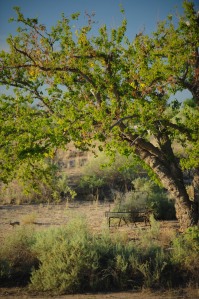
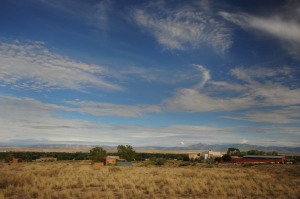


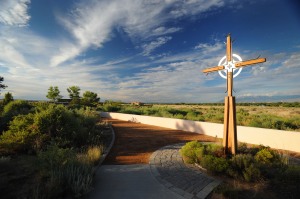




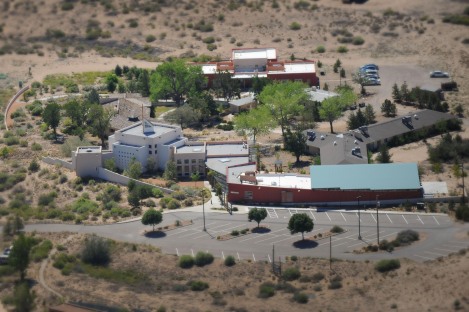
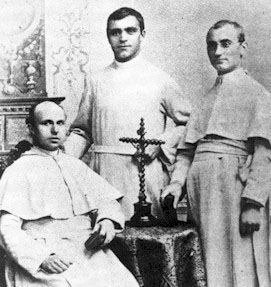 In 1893 Fr. Bernard H. Pennings and two confrères from
In 1893 Fr. Bernard H. Pennings and two confrères from 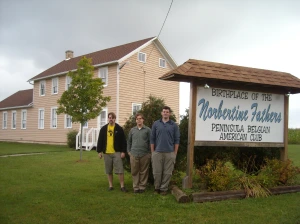 Last weekend our novice director, Fr. David, and the three novices (myself, Matt and Stephen) went up to visit these first Norbertine foundations, the first parishes given to these early Norbertine missionaries. The Norbertines came not as missionaries to convert the unbaptized to Christianity but rather to minister to existing populations of Christians; calling them to continued conversion within their own lives as settlers in a foreign land.
Last weekend our novice director, Fr. David, and the three novices (myself, Matt and Stephen) went up to visit these first Norbertine foundations, the first parishes given to these early Norbertine missionaries. The Norbertines came not as missionaries to convert the unbaptized to Christianity but rather to minister to existing populations of Christians; calling them to continued conversion within their own lives as settlers in a foreign land. To walk in the footsteps of these first brave men, men who left all they knew for a life unknown, a foreign continent, a foreign people, a foreign tongue and an often challenging way of life was profoundly moving. They challenged difficulties unimagined to provide sacramental and ministerial services, manifesting the love of God for humanity to a severely under-served population and to plant their ancient way of life in a new and growing nation. We witnessed small churches dotting the rolling hills of Door County and the petite rooms in which these men lived out their first winter.
To walk in the footsteps of these first brave men, men who left all they knew for a life unknown, a foreign continent, a foreign people, a foreign tongue and an often challenging way of life was profoundly moving. They challenged difficulties unimagined to provide sacramental and ministerial services, manifesting the love of God for humanity to a severely under-served population and to plant their ancient way of life in a new and growing nation. We witnessed small churches dotting the rolling hills of Door County and the petite rooms in which these men lived out their first winter.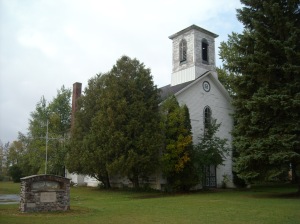 We, of course, have the priveledge of driving the long distances from parish to parish. That was not the case for these early settling Norbertines. The landscape, farmland and forests, glimpses of Lake Michigan and Green Bay appearing around bends, simple wood and brick farm houses—all remain much the same as these men had come to see it over a century ago.
We, of course, have the priveledge of driving the long distances from parish to parish. That was not the case for these early settling Norbertines. The landscape, farmland and forests, glimpses of Lake Michigan and Green Bay appearing around bends, simple wood and brick farm houses—all remain much the same as these men had come to see it over a century ago.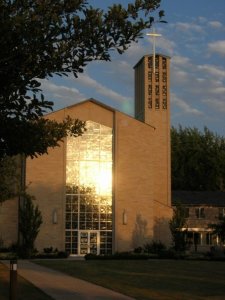 While in Wisconsin we spent several nights at
While in Wisconsin we spent several nights at 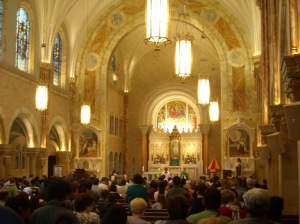 On our way back to Chicago we stopped at Holy Hill. A magificent shrine atop one of the highest points in the state of wisconsin. This moving structure, drawing flocks of pilgrims from around the world, stands as a testament to the feats humaniy will undertake in order to honor an ideal–and in reality something greater than an ideal, the foundations of truth and faith.
On our way back to Chicago we stopped at Holy Hill. A magificent shrine atop one of the highest points in the state of wisconsin. This moving structure, drawing flocks of pilgrims from around the world, stands as a testament to the feats humaniy will undertake in order to honor an ideal–and in reality something greater than an ideal, the foundations of truth and faith.